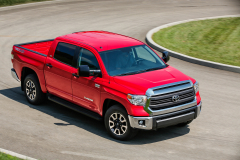DETROIT – With nothing to haul or to tow, the only way to really test drive the 2014 Toyota Tundra half ton full size 4X4 pickup truck was to approach it as a personal use fully. Actually, that is just what it was for the week-long test drive.
Of the three cab styles available on the new Tundra — a two-door regular cab, four-door double cab and four-door CrewMax – the test vehicle was the latter, a four-door Crew Max. That means that it could carry five full size adults; two in the front seats and three in the bench second row seat.
The bed was standard size at 78.7 inches long and 22.2 inches deep. Its power sliding rear window was also standard on the CrewMax model. The truck had what Toyota called a “lockable easy lower and lift tail gate” that could be lowered with no slam and it could be removed for the really awkward sized loads.
The short bed made the Tundra 4X4 relatively easy to maneuver. But the rear backup camera was really useful in the driveway and the parking lots of malls. What’s more, it took some of the angst out of parallel parking.
Three engines were available. The test vehicle had the top of the line 5.7-liter V8. It was the flex-fuel variant and generated 381 horsepower and 401 pound-feet to torque. Mated to a six-speed automatic transmission the 4X4 version of this engine had an EPA rating of 13 mpg in the city and 17 mpg on the highway.
The four-wheel-drive system was of the on demand variety. But the pavement remained dry and cold so testing it never came to mind; the truck remained in 4X2 mode for the entire week. But the system had the traditional three settings: 4X2, 4X4 Hi and 4X4 Lo ranges. Selections could be made by dial near the bottom of the center stack.
This engine was quiet, responsive and it could subtly increase speed up to 75 mph without really trying. The ride quality was smooth, for a pickup truck, because the shock absorber valves had been re-tuned. And the Tundra was really responsive to driver input because the steering system had also been retuned.
Toyota said the Tundra’s frame used wide, full-boxed rails for the front portion, a reinforced C-channel under the cab and an open C-channel underneath the bed to help maximize strength, ride quality and durability.
The double A-arm front suspension used coil-over spring shock units, while a front-mounted steering rack helped enhance steering feel and response. The rear suspension used staggered shocks mounted outboard of the springs to improve the shocks’ dampening efficiency. Spring rates were tuned to provide a flat vehicle stance when the Tundra fully loaded.
The Japanese automaker has continued to upgrade the Tundra since it went on sale in 1999. All models have four-wheel disc brakes with ventilated rotors – 13.9 inches and 1.26-inches thick with four-piston calipers in front; and 13.6 x 0.71-inch two-piston calipers in the rear.
For 2014, the Tundra has been redesigned with a more chiseled look that exudes power. The size of the front fascia has been increased and the hood and grille looked like one piece. The grille is taller and the front lower bumper is now a three piece design rather than a one-piece design for less expensive repair. The same is true of the rear bumper.
The interior was upgraded too with styling differentiations between grades. Dials were easier to reach by up to 2.6 inches. That is a lot. The seats have been redesigned and they were really comfortable. The rear seat could be folded to provide additional storage.
There was still too much metallic colored plastic but that is subjective. More important was that it didn’t look cheap and it was fairly understated. The gauges featured 3-D metallic rings and they were grouped in a clear, easy-to-see design with a center-mounted multi-information (LCD) display screen.
The center console held multiple storage areas for personal items and electronics plus additional padded surfaces and accent stitching in premium grades. Our test vehicle had bucket seats in the front but a bench seat is available.
Voice controls were standard. So was Toyota’s Entune multimedia bundle that included a 6.1 inch display screen. The radio had MP3/WMA capability; there was an auxiliary jack and USB port.
The premium Entune package which the test truck had included HD Radio with iTunes tagging and HD Traffic and Weather and satellite radio. The App Suite included Bing™, iHeartRadio, MovieTickets.com; Open Table®, Pandora®, Yelp and Facebook Places.
The 2014 Toyota Tundra was a versatile and comfortable truck and in 4X2 mode it could tow up to 10,400 lbs. For $44,459, that wasn’t bad.
Frank S. Washington is editor of AboutThatCar.com.
Frank Washington
AboutThatCar.com
PO Box 23167
Detroit,MI 48223




